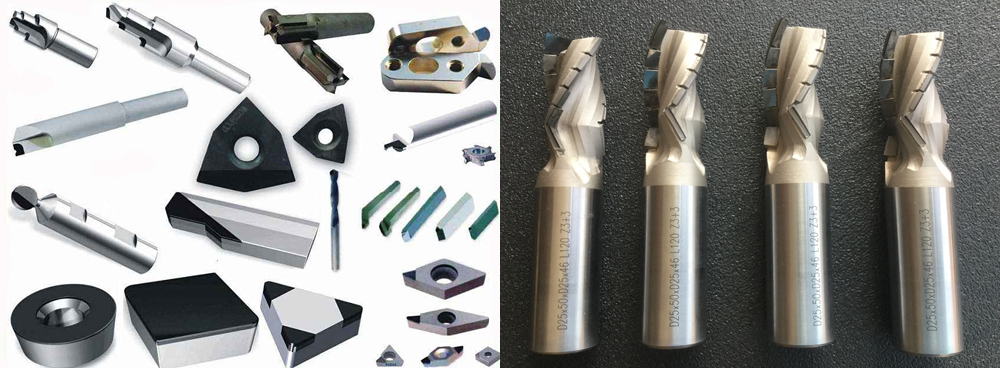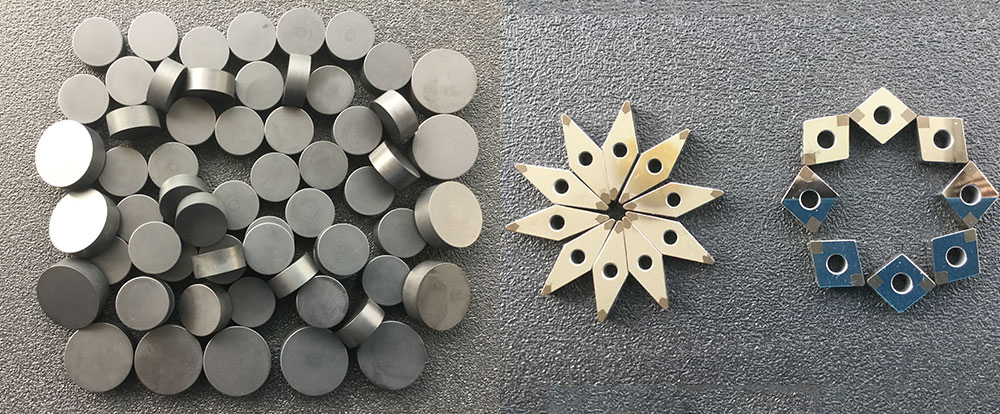
PCD Tool
Industrial developed countries to carry out research on PCD tool earlier, its application has been relatively mature. Since 1953 in Sweden for the first time synthetic synthetic diamond, the PCD tool cutting performance research has received a lot of results, PCD tool applications and usage expanded rapidly. Currently, the internationally renowned synthetic diamond composite sheet manufacturers are mainly British DeBeers company, the United States GE company, Japan Sumitomo Electric Co., Ltd. and so on. According to reports, in the first quarter of 1995 only Japan's PCD tool production reached 10. Seventy thousand. The range of applications for PCD tools has been extended from initial turning to drilling and milling. A survey conducted by a Japanese organization on the ultra-hard tools showed: people choose PCD tool is the main consideration is based on PCD tool after machining surface accuracy, dimensional accuracy and tool life and other advantages. Diamond composite sheet synthesis technology has also been a big development, DeBeers company has launched a diameter of 74mm, thickness of 0.8mm. 3mm polycrystalline Diamond composite sheet.
Domestic PCD tool market with the development of the level of tool technology has also been expanding. At present, China's first automobile Group has more than one hundred PCD turning point, many wood-based panel companies also use PCD tool for wood products processing. The application of PCD tools has also further contributed to the research of its design and manufacturing technology. Domestic Tsinghua University, Dalian University of technology, huazhong University of Science and technology, Jilin University of technology, Harbin Institute of technology and other active research in this area. Domestic engaged in PCD tool research and development, production of Shanghai schubhart, Changzhou Merck tools, Zhengzhou xinya, Nanjing Blue Flag, Shenzhen runxiang, Chengdu tool Research Institute, Chengdu dai mengdi and dozens of units. Currently, PCD tool processing range has been extended from traditional metal cutting to stone processing, wood processing, metal matrix composites, glass, engineering ceramics and other materials processing. Through the analysis of recent years PCD tool applications can be seen, PCD tool is mainly used in the following two aspects:փ difficult processing of non-ferrous metal materials processing: when using ordinary machining tool difficult non-ferrous metal materials, often produce tool easy to wear, low processing efficiency and other defects, and PCD tool can exhibit good processing performance. Such as the use of PCD tool can be effectively processed new engine piston material-eutectic silicon Aluminum alloy (the study of the material processing mechanism has made a breakthrough).Փ difficult processing of non-metallic materials processing: PCD tool is very suitable for stone, hard carbon, carbon fiber reinforced plastic (CFRP), wood-based panels and other non-metallic materials processing difficult to process. Such as huazhong University of technology in 1990 to achieve the use of PCD tool processing of glass; currently laminate flooring and other wood substrates (such as MDF)applications become increasingly widespread, with PCD tool machining of these materials can effectively avoid tool wear and other defects.

PCBN Tool
PCBN tool is an artificial cubic boron nitride tool, while maintaining high hardness characteristics at high temperatures, mainly for processing Iron.CBN (Cubic Boron Nitride Nitride)is the first 1950s by the United States General Electric(GE)company using artificial methods in high temperature and pressure conditions of synthesis, its hardness is much higher than the diamond and other materials, so it is known as the diamond superhard material.
Application Areas
Suitable For High-Speed And Ultra-High-Speed Machining:
PCBN tools are best suited for high-speed machining of cast iron, hardened steel and other materials. When the PCBN tool cutting cast iron and hardened steel tool flank wear and cutting distance relationship can be seen: when the cutting speed exceeds a certain limit, the higher the cutting speed, PCBN tool flank wear rate but smaller, that is, high-speed cutting tool life but high, this feature is especially suitable for modern high-speed machining.
Best Tool Material For Hard Cutting Technology
Hardening hardware (hardness HRC55 above)finishing, usually grinding method to complete, but with the development of the tool material and lathe (especially CNC lathe) machining accuracy, hard cutting instead of grinding to complete the final processing of parts has become a new way of finishing, this Process method to lathe has the following advantages:
(1) Can improve the processing flexibility, breaking the limit of grinding wheel, by changing the cutting edge and knife way can process different geometries of the workpiece;
(2) Cutting environmental problems increasingly grim, waste and waste grinding process produces more difficult to handle and remove, and harmful to human body, and hard state cutting without adding coolant, significant;
(3) High cutting efficiency, processing time is short, The equipment investment cost is small, can reduce the processing cost;
(4) Removal of the same volume of energy consumed only 20% of the grinding, resulting in less cutting heat, the surface is not easy to cause burns and small cracks, easy to maintain the integrity of the surface properties of the workpiece;
(5) In the case of the same metal removal rate, hard state cutting than grinding energy saving.
Typically used for hard cutting tool materials are ceramic, TiC coated blades and PCBN tool materials, but to hard state turning at higher speeds(1000m/min or more), PCBN is the best tool material variety. As in automotive transmission Synchronizer sets fork (material 20CrMnTi, hardness of HRC58 ~ 62)processing uses to replace the mill, the efficiency of more than four times, reduce processing costs for the original grinding process 1/3 to 1/2.
Ideal Tool Material For Dry Machining
Due to economic and environmental reasons, in recent years, dry machining method has become the focus of research in the field of machine manufacturing. Let's take a look at the wet cutting process:
(1) Long-term exposure to air or cutting the cutting fluid mist caused by the heat of the cutting volatile, easy to pollute the environment, endangering the health of the operator, the cutting fluid sulfur, chlorine and other additives greater harm, affecting the quality of the surface:
(2) The impact of the use of cutting fluid processing costs, according to statistics, cutting fluid accounts for 15% of production costs, while the cost of the tool only 3% to 4%:
(3) Cutting fluid leakage, overflow will pollute the environment, prone to safety, quality accident:
(4) Cutting fluid transmission, recycling, filtration and other equipment and maintenance costs higher, increasing the cost of production.
Due to the above reasons, the dry cutting process has been developed in the western industry has considerable application. Recommended by the United States Makino company ”Red Crescent " (Red Crescent)dry cutting process, both to give full play to the cutting tool performance, compared with wet cutting can greatly improve productivity. The mechanism is due to the high cutting speed, the heat generated gathered in the front of the tool, so that the material near the cutting zone reaches the Red Hot state, the yield strength decreased, and thus to improve the cutting efficiency of the effect. Red Crescent dry cutting process precondition is at a higher cutting temperature, cut material strength decreased significantly, it becomes easy to cut, and the strength of the tool material in the same state to have better red hardness and thermal stability, but also better wear resistance and adhesion.
Suitable for dry cutting process tool materials are ceramic, cermet, cemented carbide coating and PCBN tool materials, etc., but the Red hard and thermal stability is concerned, PCBN material is the most suitable for dry cutting process tool material, and because PCBN tool material has the above advantages, more suitable for high-speed dry cutting conditions, compared with PCBN tool gray cast iron cutting and wet cutting in both cases can be seen: PCBN in the case of high-speed dry cutting, wet cutting tool has a higher than the cutting life.
Adapts to automated processing and hard-to-machine material processing
PCBN tools have high hardness and wear resistance, can be processed at high cutting speeds for a long time high-precision parts(small size dispersion), greatly reducing the number of tool change and tool wear compensation downtime time spent. Therefore, it is suitable for CNC machine tools and high degree of automation processing equipment, and can make the equipment of high performance to give full play.
In the difficult material applications, PCBN tool also shows its excellent performance, such as surface welding (coating)material processing, with other materials tool machining, tool life is very low, it can not use the grinding method, and PCBN is the only suitable tool material; another example, in the oil power plant equipment used in high-alloy wear-resistant cast iron, using PCBN tool than carbide tools to improve the cutting efficiency of more than four times, the cost of cutting tools dropped to the original 1/5.Also in terms of cutting tungsten carbide sintered materials, PCBN tool also shows good cutting performance.
Application examples of PCBN tools
Since PCBN has high hardness and wear resistance, chemical inertness does not react at high temperatures with iron metals, it is mainly used for cutting of high hardness materials and hard materials, such as hardened steel, high-alloy cast iron, high-temperature alloys, high-speed steel, surface spray welding materials, sintered metal materials and other hard materials.
(1) processing hardened steel, can play to the effect of turning mill, due to the depth of cutting more than ten times greater than the depth of grinding, so the high processing efficiency, the surface does not produce burns. Such as the shift slip gear(20CrMnTi, hardness HRC58 ~ 62) when the milling, cutting more than four times the original grinding processing efficiency.
(2) processing of high alloy (including tungsten or chromium 18%)wear-resistant cast iron, cutting speed than carbide tools increased by more than 10 times, cutting efficiency increased by more than 4 times.
(3) processing of high cobalt-chromium molybdenum corrosion resistant heat-resistant alloy, PCBN tool cutting speed of 160m/min, is 8 times the tungsten carbide tool.
(4) processing thermal spraying (spray welding)materials, surface welding parts can not be used grinding, and carbide cutting tool cutting efficiency is very low, after switching to PCBN tool can improve processing efficiency, save processing costs more than 50%.PCBN tools can also be used for precision cutting of non-ferrous metals and cutting of sintered metals and so on.

Prev:PDC Drill Bit
Next:Single Crystal Diamond Tool
PRODUCTS:
Copyright © 2018 Henan Baililai Superhard Materials Co., Ltd. All rights reserved. Powered by MetInfo
TOP

 简体中文
简体中文 English
English Pусский
Pусский
.jpg)